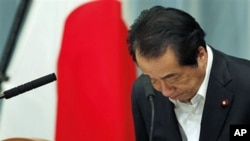The leaders of Japan, South Korea, and China are visiting the city nearest to the nuclear plant that has been leaking radiation since the devastating March 11 tsunami and earthquake.
The three leaders are scheduled Saturday to go to an evacuation center to offer condolences to those displaced by the accident. Afterward, the leaders will proceed to Tokyo for a two-day summit.
The summit, the fourth annual meeting of the three Asian leaders, is expected to focus on increasing cooperation for dealing with natural disasters and on nuclear safety, as well as trade issues. Japan has been looking forward to the summit as a chance to mend ties with China following a bitter territorial dispute last year.
But preparations hit a snag earlier this week, when Japan's prime minister Naoto Kan proposed opening the meeting at Fukushima. In an editorial Thursday, China's Communist party-controlled Global Times accused Japan of mishandling the event. The paper said it is "rare" for a host country to be vague about the location of a major summit just days before it is to begin and described the confusion over the venue as "a diplomatic setback" that "never should have occurred."
Japan's proposal was dropped, and the leaders agreed instead to the visit with evacuees. South Korean president Lee Myung-Bak and Chinese Premier Wen Jiabao also will pay separate visits further north in Japan to areas devastated by the March 11 earthquake and tsunami.
Radiation continues to leak from the Fukushima plant, where cooling systems were knocked out by the tsunami leading to core meltdowns in at least one and as many as three of the six reactors.
Some information for this report was provided by AFP.













